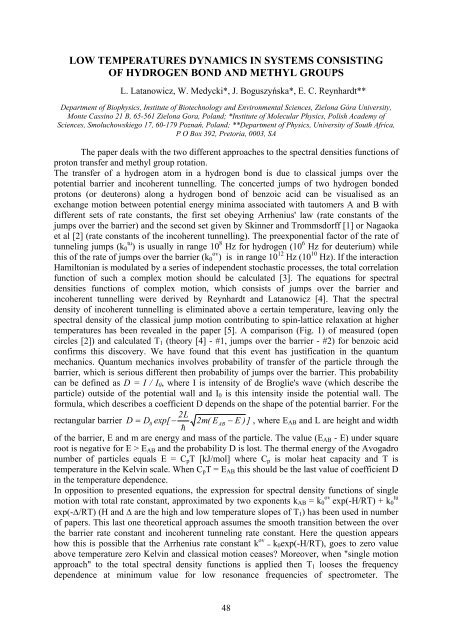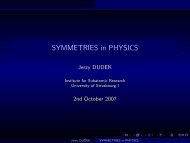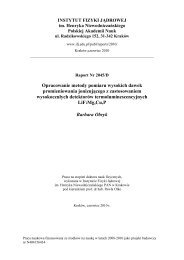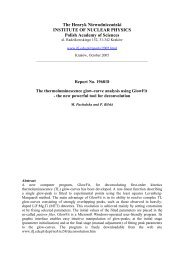Report No xxxx - Instytut Fizyki JÄ drowej PAN
Report No xxxx - Instytut Fizyki JÄ drowej PAN
Report No xxxx - Instytut Fizyki JÄ drowej PAN
You also want an ePaper? Increase the reach of your titles
YUMPU automatically turns print PDFs into web optimized ePapers that Google loves.
LOW TEMPERATURES DYNAMICS IN SYSTEMS CONSISTING<br />
OF HYDROGEN BOND AND METHYL GROUPS<br />
L. Latanowicz, W. Medycki*, J. Boguszyńska*, E. C. Reynhardt**<br />
Department of Biophysics, Institute of Biotechnology and Environmental Sciences, Zielona Góra University,<br />
Monte Cassino 21 B, 65-561 Zielona Gora, Poland; *Institute of Molecular Physics, Polish Academy of<br />
Sciences, Smoluchowskiego 17, 60-179 Poznań, Poland; **Department of Physics, University of South Africa,<br />
P O Box 392, Pretoria, 0003, SA<br />
The paper deals with the two different approaches to the spectral densities functions of<br />
proton transfer and methyl group rotation.<br />
The transfer of a hydrogen atom in a hydrogen bond is due to classical jumps over the<br />
potential barrier and incoherent tunnelling. The concerted jumps of two hydrogen bonded<br />
protons (or deuterons) along a hydrogen bond of benzoic acid can be visualised as an<br />
exchange motion between potential energy minima associated with tautomers A and B with<br />
different sets of rate constants, the first set obeying Arrhenius' law (rate constants of the<br />
jumps over the barrier) and the second set given by Skinner and Trommsdorff [1] or Nagaoka<br />
et al [2] (rate constants of the incoherent tunnelling). The preexponential factor of the rate of<br />
tunneling jumps (k tu 0 ) is usually in range 10 8 Hz for hydrogen (10 6 Hz for deuterium) while<br />
this of the rate of jumps over the barrier (k ov 0 ) is in range 10 12 Hz (10 10 Hz). If the interaction<br />
Hamiltonian is modulated by a series of independent stochastic processes, the total correlation<br />
function of such a complex motion should be calculated [3]. The equations for spectral<br />
densities functions of complex motion, which consists of jumps over the barrier and<br />
incoherent tunnelling were derived by Reynhardt and Latanowicz [4]. That the spectral<br />
density of incoherent tunnelling is eliminated above a certain temperature, leaving only the<br />
spectral density of the classical jump motion contributing to spin-lattice relaxation at higher<br />
temperatures has been revealed in the paper [5]. A comparison (Fig. 1) of measured (open<br />
circles [2]) and calculated T 1 (theory [4] - #1, jumps over the barrier - #2) for benzoic acid<br />
confirms this discovery. We have found that this event has justification in the quantum<br />
mechanics. Quantum mechanics involves probability of transfer of the particle through the<br />
barrier, which is serious different then probability of jumps over the barrier. This probability<br />
can be defined as D = I / I 0 , where I is intensity of de Broglie's wave (which describe the<br />
particle) outside of the potential wall and I 0 is this intensity inside the potential wall. The<br />
formula, which describes a coefficient D depends on the shape of the potential barrier. For the<br />
2L<br />
rectangular barrier D = D exp[ − 2m( E E ) ] , where E AB and L are height and width<br />
0 AB<br />
−<br />
<br />
of the barrier, E and m are energy and mass of the particle. The value (E AB - E) under square<br />
root is negative for E > E AB and the probability D is lost. The thermal energy of the Avogadro<br />
number of particles equals E = C p T [kJ/mol] where C p is molar heat capacity and T is<br />
temperature in the Kelvin scale. When C p T = E AB this should be the last value of coefficient D<br />
in the temperature dependence.<br />
In opposition to presented equations, the expression for spectral density functions of single<br />
motion with total rate constant, approximated by two exponents k AB = k ov tu<br />
0 exp(-H/RT) + k 0<br />
exp(-∆/RT) (H and ∆ are the high and low temperature slopes of T 1 ) has been used in number<br />
of papers. This last one theoretical approach assumes the smooth transition between the over<br />
the barrier rate constant and incoherent tunneling rate constant. Here the question appears<br />
how this is possible that the Arrhenius rate constant k ov = k 0 exp(-H/RT), goes to zero value<br />
above temperature zero Kelvin and classical motion ceases? Moreover, when "single motion<br />
approach" to the total spectral density functions is applied then T 1 looses the frequency<br />
dependence at minimum value for low resonance frequencies of spectrometer. The<br />
48

















